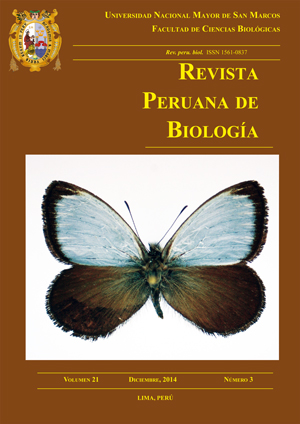Mammal Hunting in the Special Use Zone and Buffer Tingo Maria National Park, Huánuco, Peru
DOI:
https://doi.org/10.15381/rpb.v21i3.10904Keywords:
Protected Natural Area, methods of hunting, hunted species, vulnerable, montane rain forests.Abstract
Between the months of August to November 2011 were conducted 42 semi-structured interviews to assess the hunting of mammals in areas of special purpose (ZUE) and buffer (ZA) National Park Tingo María surveys. The results indicate that 43% of the population practiced hunting as a secondary activity, the main smallholder agriculture. The methodology used for hunting are the "tramperas" while the hunting is often 2-3 times a month. Hunting is more common after the wet season, it is selective and responds to the taste of meat that an economic need. Among the most hunted mammals include agouti Dasyprocta sp. and picuro Cuniculus paca, while animals higher biomass as the peccary Pecari tajacu are rare in the area, so it is recommended to increase the control of hunting of vulnerable species in the villages which are inside and in the vicinity of the Park.Downloads
Downloads
Published
Issue
Section
License
Copyright (c) 2014 Fiorella Nasha Gonzales Guillén, Gabriel Llerena Reátegui

This work is licensed under a Creative Commons Attribution-NonCommercial-ShareAlike 4.0 International License.
AUTHORS RETAIN THEIR RIGHTS:
a. Authors retain their trade mark rights and patent, and also on any process or procedure described in the article.
b. Authors retain their right to share, copy, distribute, perform and publicly communicate their article (eg, to place their article in an institutional repository or publish it in a book), with an acknowledgment of its initial publication in the Revista Peruana de Biologia.
c. Authors retain theirs right to make a subsequent publication of their work, to use the article or any part thereof (eg a compilation of his papers, lecture notes, thesis, or a book), always indicating its initial publication in the Revista Peruana de Biologia (the originator of the work, journal, volume, number and date).






